Center for Medical Simulation Educational Technologies of the Higher School of Medicine
Center for Medical Simulation Educational Technologies of the Higher School of Medicine
The Center for Medical Simulation Educational Technologies at the Higher School of Medicine has been operating since 2018.
The director of the Higher School of Medicine since its foundation has been Svetlana Kabdenovna Muratbekova, MD.
Head of the simulation center Shaizadaeva Asel Askarovna.
The purpose of the center is to improve the quality of professional training of students through the development and improvement of special medical skills and abilities using modern simulators and virtual simulators.
Practicing practical skills in the simulation center is a mandatory component of the training of future doctors (Corresponds to the State Educational Standard Order No. № ҚР ДСМ-63 dated July 4, 2022)
The objectives of the center:
- Simulation of medical emergencies: Preparing students to work in emergency situations to develop first aid skills.
- Interactive practice in surgery, traumatology and obstetrics and gynecology: enabling students to virtually perform necessary medical interventions using interactive mannequins. It helps to develop motor skills, coordination and decision-making in various scenarios.
- Communication skills training: simulation of communication scenarios with patients, their families and colleagues. Training in effective interaction, understanding patient needs and communicating information.
- Scenarios for the management of medical resources: simulation of situations where it is necessary to effectively manage medical resources, make decisions about treatment priorities, the allocation of personnel and equipment in conditions of limited resources.
- Training in working with the latest medical equipment: providing students with access to modern medical technologies through simulators, VR technologies and the use of artificial intelligence (AI). Training in the use of medical devices, diagnostic equipment and life support systems.
- Simulation of clinical examinations: the practice of conducting clinical examinations of patients, including anamnesis, physical examination and diagnostic procedures. This helps students develop observation, analysis and diagnostic skills.
- Ethical and professional aspects training: simulation of scenarios involving ethical dilemmas, confidentiality and interaction with patients in difficult situations. Training in proper decision-making and management in accordance with medical ethics.
- Organization and conduct of an objective structured clinical examination (OCE) covering all levels of education, organization and control of methodological support for the OCE.
The equipment of the CMSET:
The center consists of 9 rooms with a total area of 426.8 sq.m.
Equipped with simulation rooms for surgery, traumatology with laparoscopy, obstetrics and gynecology, intensive care, nursing, a "Virtual Medical Academy" with Dr. Sim software support, a VR technology room, a standardized patient room and an "Independent Knowledge Assessment Center".
All rooms of the center are equipped with modern simulation equipment, a variety of simulators and mannequins, as well as audio-video equipment and computer equipment. All study rooms are also equipped with computers with Internet access.
Room No. 13 "Standardized Patient's room" is a space for training medical professionals in communication skills. In this room, trained specialists assume the roles of patients, recreating various clinical scenarios. Using audio-video recording and analysis tools, students improve communication, diagnostic and empathy skills. The Standardized Patient's room plays a key role in preparing for real clinical situations.
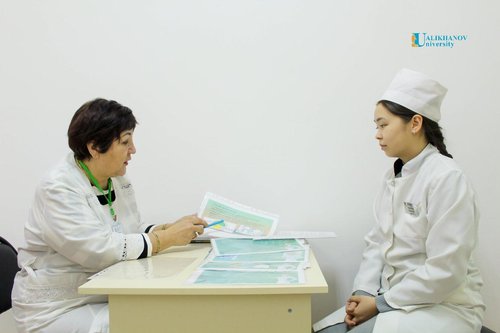
Room No. 14 "Center for Independent Assessment of Knowledge"
The office is equipped with a patient triage system; an ultrasound simulator for conducting research and interpreting results, equipped with a set of 3 realistic ultrasound sensors (convex, linear and sector phased), 1 reference system module, a set of 20 radio frequency tags, a USB drive including VausSim software; an ECG device and an otoscopy dummy. Here, students and medical staff can train in priority sorting of patients into groups, based on the urgency and uniformity of necessary measures (therapeutic, preventive, evacuation) in a specific situation, conduct ultrasound examinations, conduct and analyze the results of ECG examinations and perform otoscopy.
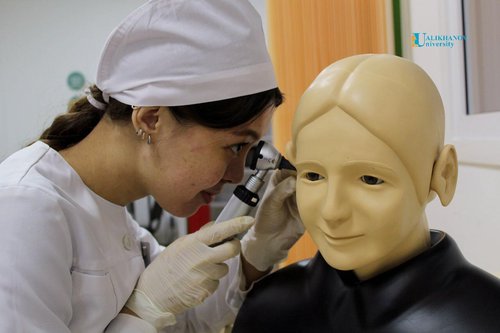
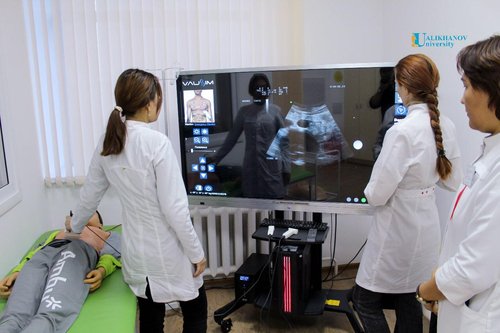
Room No. 15 "Virtual Medical Academy" with Dr. Sim software support
The Virtual Medical Academy office is an innovative educational space equipped with Dr. Sim software. Here, teachers simulate a variety of clinical scenarios for students to practice diagnostic and decision-making skills in a virtual environment. The software allows you to create interactive simulations, emulating various medical situations, from everyday cases to complex pathologies. The office promotes the education of students using advanced technologies, increasing their competence in medical practice.
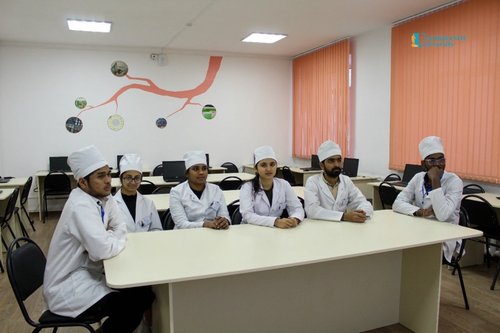
Room No. 16 "Obstetrics and gynecology"
It is equipped with modern simulators for practical training in the field of obstetrics and gynecology, such as an instrumental childbirth simulator, a multifunctional childbirth simulator not only reliably simulates normal childbirth, but also teaches the management of pathological and multiple births. The cabinet is also equipped with fetal models of a premature newborn and a newborn baby, a multifunctional computerized birth simulation dummy that can reproduce various prenatal complications, normal and high-risk childbirth, as well as emergency postpartum conditions, which are extremely important for developing skills taking into account the current skill level and group interaction, conducts the fetus through all stages of labor for a realistic repeatable simulations of childbirth. Built-in sensors monitor the actions of students and transmit the relevant data to the instructor in real time, two newborn mannequins are attached to the kit for a realistic simulation of childbirth with head and pelvic presentation. Students can palpate cranial sutures and fontanelles. A newborn's dummy to simulate a head presentation is capable of reproducing the sound of a heartbeat before, during and after birth. The monitoring technology allows you to receive real-time information about the effort made by the intern to the fetus.
This room provides students with the opportunity to practice in various aspects of obstetrics and gynecology, providing realistic training in important medical procedures.
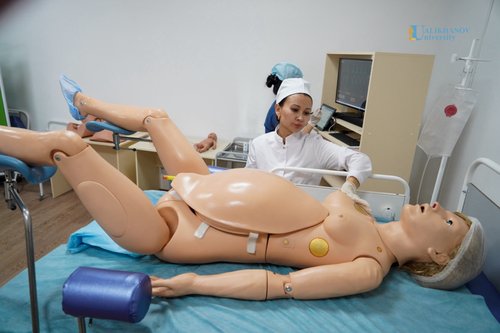
Room No. 17 "VR Technology Room"
It is a modern hardware and software VR complex for medical education. The equipment includes licensed software packages and simulators: "Emergency medical care station", "Emergency medical care". Academix 3D virtual educational system for internal medicine" for simulating various internal diseases for teaching diagnosis and treatment.
The classroom provides students with a unique opportunity to study in a realistic virtual environment, enhancing practical skills and deepening their understanding of medical procedures.
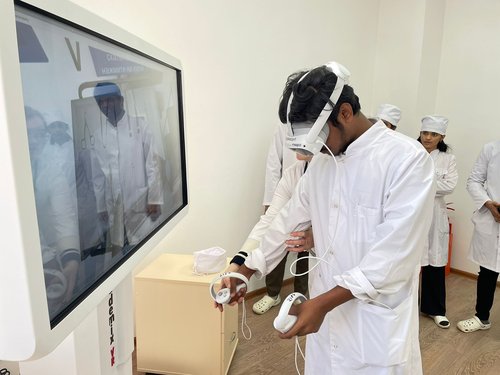
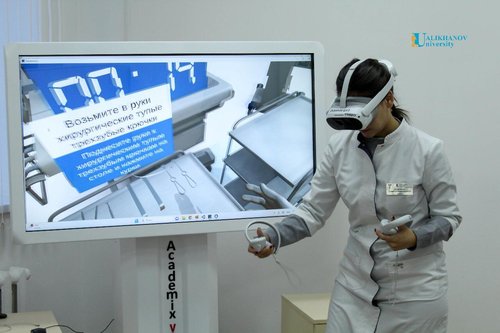
Room No. 18 - "Intensive care"
It is equipped with modern equipment for first aid training and cardiopulmonary resuscitation for adult and pediatric patients. It presents: a phantom system for defibrillation and cardiopulmonary resuscitation with Wi-Fi support for real-time training, defibrillators for training in the use of devices to restore heart rhythm, a simulator to assist with complete respiratory obstruction, a dummy simulator of a 5-year-old child with monitoring of the course of cardiopulmonary resuscitation.
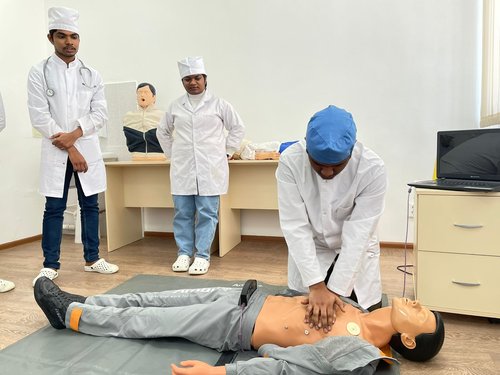
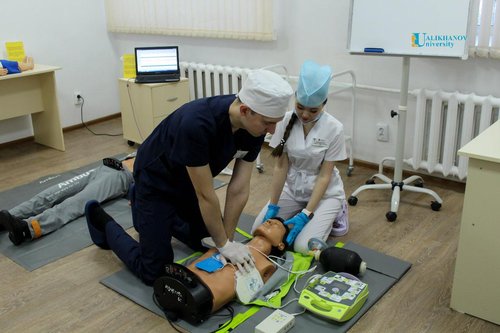
Room No. 19 - "Surgery"
Provides training for students and medical staff in surgical procedures. It includes: A simulator for tracheostomy, an electric model for intubation of the adult trachea, a mannequin for puncture and drainage of the pleural cavity with imitation of pneumothorax and hydrothorax, a simulator for catheterization of central veins, a training model for intubation of the trachea of a newborn with Ambu-type bags and a laryngoscope, an intubation simulator for an infant with Ambu-type bags. There is also a VR hardware and software complex with licensed programs and simulators installed in the office:
"Indirect ophthalmoscopy", "Tracheostomy operation", "Training of communication skills". Academic 3D virtual educational system for internal medicine - teaching pathology of internal organs.
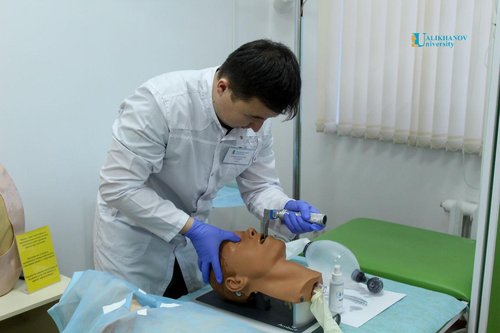
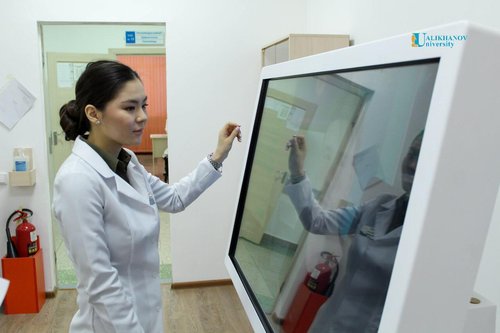
Room No. 20 - "Nursing"
Equipped with a mannequin for patient care, they provide the perfect combination of opportunities for nursing practice and primary intensive care. It allows monitoring the effectiveness of CPR, practicing the skills of conventional or counterpulsation CPR, mouth-to-mouth artificial respiration, variable palpable pulse in the carotid artery, oral and nasal intubation, restoration of airway patency, intubation using a Miller blade and an endotracheal tube FR or laryngeal mask, tracheostomy, practicing intravenous, intramuscular and subcutaneous skills procedures, gastric lavage and feeding through a probe, etc. The office also has full-featured models for various injections in adults and children, a virtual educational system Academix 3D complete with internal medicine, including sections of pulmonology, cardiology, gastroenterology, etc.
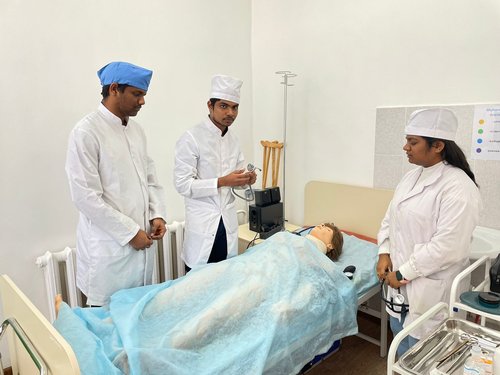
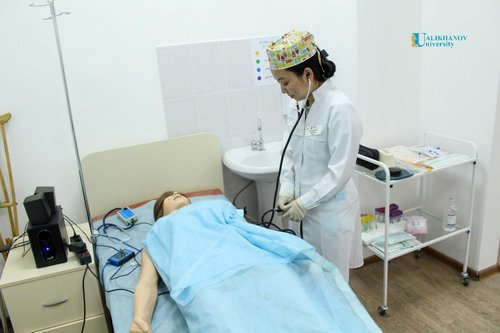
Room No. 17a Traumatology with laparoscopy
The office is equipped with the latest equipment: an injury simulation dummy, created to work out algorithms for various injuries, which allows intubation using all devices used in practice to ensure the patency of the respiratory tract, endotracheal tubes, laryngeal masks, allows the introduction of liquids into the esophagus with the possibility of their subsequent drainage, ventilation (hereinafter ventilator) using a bag Ventilator or ventilator, has the function of simulating bleeding from wounds, is able to reproduce various sounds of the upper respiratory tract, it has the ability to palpate the pulse of the carotid and femoral on both sides, radial (right), display and be able to select the type of ECG of the patient (dummy), the possibility of defibrillation, cardioversion and pacing, real resuscitation equipment (external automatic defibrillator), has areas for practicing skills of subcutaneous and intramuscular injections on both arms and legs, a built-in system for playing phrases, cues and voice effects.
This room is equipped with a surgical medical simulator complete with laparoscopic surgery, which allows you to practice manual skills related to minimally invasive operations.
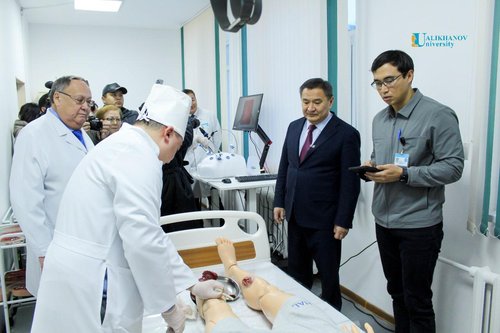
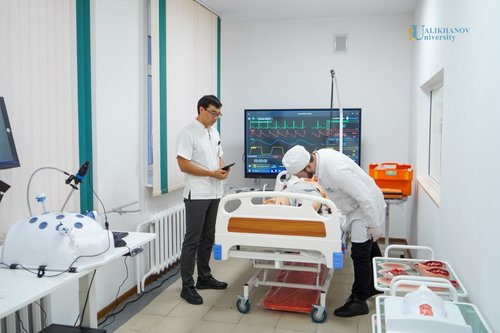
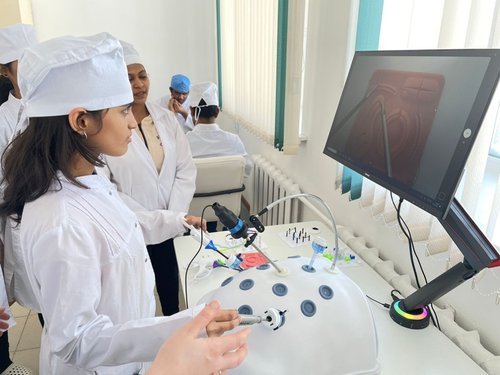
Room No. 2 of the Department of Morphology, Physiology and General Pathology
At the Department of Morphology, Physiology and General Pathology there is an Interactive anatomical table "Pirogov" with a hardware and software complex of a three-dimensional image of the human body with a mobile application for 500 licenses. Its built-in database contains more than 4,000 3D models with natural colors, the correct shape and, in general, a very natural and realistic look. The capabilities of the table allow you to simulate more than 100 common pathological conditions of the body. The work of the table includes 4 modes: viewing, diagnostics, comparison and knowledge verification. The Pirogov interactive table is one of the best tools for studying anatomy, physiology and medicine in general.
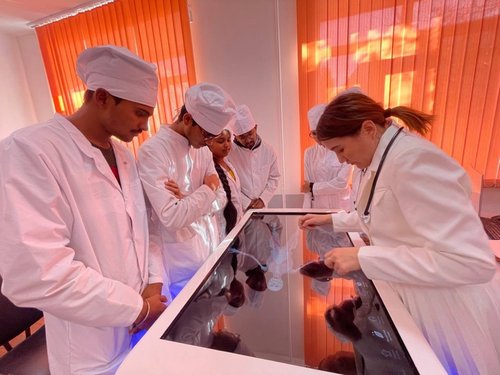
Our address: Akana-Sere 1a, building of the Higher School of Medicine, 2nd floor
E-mail: medicine@shokan.edu.kz